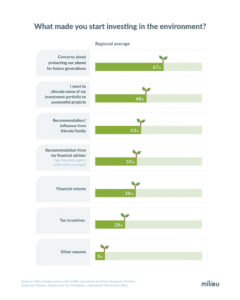Green investing for our planet

As the Earth Day theme for this year goes, “Invest in Our Planet;” for investing in a green economy, according to EARTHDAY.ORG, is “the only path to a healthy, prosperous, and equitable future.”
The organization highlighted that in investing in the planet’s future, everyone has a role, from the government, the private sector, to individuals. Businesses, inventors, investors, and financial markets, for their part, have to “drive value for their institutions and society through green innovation and practices.”
A significant investment is needed to build a greener economy, according to the World Economic Forum. And for countries like the Philippines, which is among those most vulnerable to the impact of climate change, investments in the environment are critical. Fortunately, sustainability has been gaining attention at present, including among investors.
In Southeast Asia, there is only one in ten that are actively making green investments, based on a recent survey conducted by consumer research and data analytics firm Milieu Insight, which sought to understand the interests of consumers and investors towards green financing and investments.
Among the six countries studied in the region, Malaysia leads in the green finance movement, having the highest proportion of green investors at 17%. Thailand has the smallest proportion with 6%.
But among the respondents who have supported green investments, 70% have expanded their allocation in the past two years. This suggested “an optimistic outlook towards contributing to a more sustainable future,” Milieu Insight noted. Among the surveyed in the Philippines, 39% said they have significantly grown their allocation to green investments, while 34% said they slightly increased.

The top two reasons that pushed respondents from the region to begin in green investing were concerns about protecting the environment for the generations to come (67%) and to allocate some of their investment portfolio to purposeful projects (48%).
While the number of respondents who have been actively investing in the green sector was low, more could invest in the sector in the future. Over half (53%) of those that have not invested yet are willing to do so in the time ahead. However, 41% are still uncertain about green investing.
So for investors interested to go green, where can they put their money into for the better of the planet, or simply put, make green investments?
While usually related to ESG (environmental, social, and governance), socially responsible investing, or impact investing, green investment is particularly focused on the environment, while the former investments also touch on social impact.
Green equities, funds, and bonds are among the ways of making green investments, thus merely means investing in organizations aiming to create a positive impact on the environment, whether through their services or business practices.
Investors could go green by purchasing stocks in businesses with initiatives committed to the environment or investing in mutual funds that uphold good or impactful environmental practices. They could invest in green bonds as well, commonly known also as climate bonds, which are a fixed-income instrument utilized for funding projects that would benefit the environment or the climate.
What makes an investment green might differ among investors. Green investments can be pure-play, which may involve organizations primarily engaged in technological developments of renewable energy, for instance. But other investors also support businesses that are “green” in the sense that they operate with environmental-friendly practices such as recycling, water conservation, or ensuring energy efficiency.
In the aforementioned study by Milieu Insight in Southeast Asia, most of the green investments were in waste management (57%), renewable energy (54%), and green transportation (50%). The Philippines’ top green investment sector is waste management (66%), while renewable energy and green transportation were at 55% and 48%, respectively.
The question now is how investors can make certain that the companies they are investing in do have services and practices that are good for and improve the environment. This could be complex as some companies might be greenwashing, or making misleading or exaggerated claims about the business, their products, or their efforts being environmental-friendly to coax investors (and consumers), especially with the increasing interest towards eco-friendliness and sustainability nowadays. PricewaterhouseCooper’s (PwC) Global Investor Survey 2022, in fact, found that 87% of respondents think that there is at least some greenwashing in corporate reporting.
As such, investors must figure out what they consider as green and research exhaustively into companies they are looking to invest in to assure themselves that the business operations are mindful of or indeed doing good for the environment.
Aside from ensuring that their investments support the environment, green investors, of course, would expect returns.
Looking at ESG, PwC showed in its Asset and Wealth Management Revolution 2022 that 60% of institutional investors reported that, comparing ESG investing and non-ESG equivalents, the former has already brought about higher performance yields. Furthermore, the firm noted that among the surveyed asset managers, nine of ten considered ESG integration into their investment strategy would make overall returns better.
Still, just like other investments, green investors have to assess the possible risks and returns in making green investments. Only they must also ensure that their investments go for the betterment of the planet.
The previous year saw sustainable funds underperform traditional funds a bit amid the challenging market conditions, according to Morgan Stanley Institute for Investing’s report on Sustainable Reality.
Nonetheless, the investment bank also reported that sustainable funds continued to see strong demand, as sustainable funds’ assets under management (AuM) amounted to almost $2.8 trillion by the end of last year, expanding its proportion of overall AuM from its 4% five years ago to 7%.
PwC’s report projected ESG-related AuM to rise from $18.4 trillion in 2021 to $33.9 trillion or 21.5% of total AuM globally by 2026, with a compound annual growth rate expected to be 12.9%. — Chelsey Keith P. Ignacio



